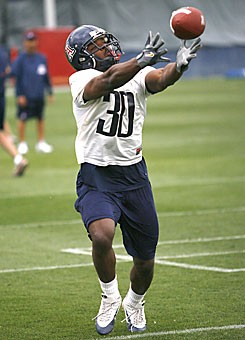According to unofficial poll results from Arizona coaches, the fight for the No. 1 running back job might just end up with two winners.
Sonny Dykes’s new spread offense promises playing time for whichever candidate proves adept in the hot-button areas.
“”We need two great running backs, and they’ll push each other,”” said head coach Mike Stoops. “”I’m not that concerned. I think competition is good at the position.
“”I think Xavier is a very talented runner, along with Chris. I think both of them will serve a purpose in this offense.””
Jennings, who started six games last season and backed up Chris Henry for five others, is Al Gore to Henry’s Bill Clinton at this point – the (relatively) seasoned veteran favored to inherit the top job.
But Smith, last year’s No. 3 back, might benefit if he can impress an open-minded constituency: in this case, an offensive coordinator who just wants someone to do something good with the ball.
“”Our offense isn’t a cookie-cutter offense. We don’t expect everyone to do every thing,”” Dykes said. “”The guys that can do certain things will do those things, and those (who) can’t, won’t.””
In Dykes’ scheme, a mix of those found at Texas Tech and Brigham Young, the running back is expected to carry and catch with equal aplomb.
Last season, the Red Raiders’ Shannon Woods averaged 6.1 yards on 152 carries and hauled in 72 passes. BYU’s Curtis Brown rushed for 1,010 yards and had a team-high 62 receptions.
What both players shared was a lack of competition. At BYU – whose system Arizona’s will most resemble – the second-leading rusher, Fui Vakapuna, finished with 92 carries to Brown’s 201 and had only 11 catches.
Those results suggest that whoever is elected the starter in September could become the backfield’s commander-in-chief, at least in terms of touches.
At present, the situation mirrors the Cougars’ this spring. BYU is pitting the junior Vakapuna against another on-field unknown (junior Manase Tonga) with Brown, like Henry, bound for the NFL.
Dykes said early points will go to the player who blocks the best on blitzes, a key ability for rushers in the pass-heavy scheme. The role will be especially important given the Wildcats’ young offensive line and oft-hit Willie Tuitama at quarterback.
Smith said his focus this spring is improving his receiving skills, while Jennings is working on reading which gaps in the line to run through.
So far, the soft-spoken Smith is pushing a platform of modesty.
“”I’m trying to just do everything,”” Smith said. “”I’m going to try to make myself better at everything, just as well as everybody else.””
Jennings has adamantly praised the new system, in part because it allows him the field space to be more instinctive with the ball than under former coordinator Mike Canales.
When asked what would nail down victory for him this offseason, Jennings promised only a good race.
“”That’s all I’m doing, is competing,”” he said. “”That’s the name of the game, is compete. I just can’t wait to get out here and compete. I love it.””









